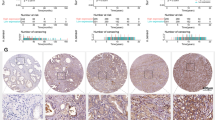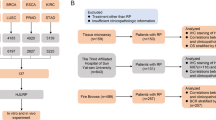Abstract
p66Shc, an isoform of Shc adaptor proteins, is shown to mediate various signals, including cellular stress. However, little is known about its involvement in carcinogenesis. We previously showed that p66Shc protein level is upregulated by steroid hormones in human carcinoma cells and is higher in prostate cancer (PCa) specimens than adjacent noncancerous cells. In this study, we investigated the role of p66Shc protein in PCa cell proliferation. Among different PCa cell lines tested, p66Shc protein level showed positive correlation with cell proliferation, that is, rapid-growing cells expressed higher p66Shc protein than slow-growing cells. Exposure of slow-growing LNCaP C-33 cells to epidermal growth factor (EGF) and 5α-dihydrotestosterone (DHT) led to upregulation of proliferation and p66Shc protein level. Conversely, growth suppression of fast-growing cells by cellular form of prostatic acid phosphatase (cPAcP) expression, a negative growth regulator, downregulated their p66Shc protein level. Additionally, increased expression of p66Shc protein by cDNA transfection in LNCaP C-33 cells resulted in increased cell proliferation. Cell cycle analyses showed higher percentage of p66Shc-overexpressing cells at S phase (24%) than control cells (17%), correlating with their growth rates. On the other hand, transient knock-down of p66Shc expression by RNAi in rapidly growing cells decreased their proliferation as evidenced by the reduced cell growth as well as S phase in p66Shc-knocked down cells. The p66Shc signaling in cell growth regulation is apparently mediated by extracellular signal-regulated kinase/mitogen-activated protein kinase (ERK/MAPK). Thus, our results indicate a novel role for p66Shc in prostate carcinogenesis, in part, promoting cell proliferation.
This is a preview of subscription content, access via your institution
Access options
Subscribe to this journal
Receive 50 print issues and online access
$259.00 per year
only $5.18 per issue
Buy this article
- Purchase on Springer Link
- Instant access to full article PDF
Prices may be subject to local taxes which are calculated during checkout







Similar content being viewed by others
Accession codes
Abbreviations
- Ab:
-
antibody
- cPAcP:
-
cellular form of prostatic acid phosphatase
- DHT:
-
5α-dihydrotestosterone
- ECL:
-
enhanced chemiluminescence
- EGF:
-
epidermal growth factor
- ERK/MAPK:
-
extracellular signal-regulated kinases/mitogen-activated protein kinases
- FBS:
-
fetal bovine serum
- GFP:
-
green fluorescent protein
- PCa:
-
prostate cancer
- ROS:
-
reactive oxygen species
References
Davol PA, Bagdasaryan R, Elfenbein GJ, Maizel AL and Frackelton Jr AR . (2003). Cancer Res., 63, 6772–6783.
Gioeli D, Mandell JW, Petroni GR, Frierson Jr HF and Weber MJ . (1999). Cancer Res., 59, 279–284.
Horoszewicz JS, Leong SS, Kawinski E, Karr JP, Rosenthal H, Chu TM, Mirand EA and Murphy GP . (1983). Cancer Res., 43, 1809–1818.
Igawa T, Lin FF, Lee MS, Karan D, Batra SK and Lin MF . (2002). Prostate, 50, 222–235.
Iizumi T, Yazaki T, Kanoh S, Kondo I and Koiso K . (1987). J. Urol., 137, 1304–1306.
Jackson JG, Yoneda T, Clark GM and Yee D . (2000). Clin. Cancer Res., 6, 1135–1139.
Kaighn ME, Narayan KS, Ohnuki Y, Lechner JF and Jones LW . (1979). Invest. Urol., 17, 16–23.
Klaunig JE and Kamendulis LM . (2004). Annu. Rev. Pharmacol. Toxicol., 44, 239–267.
Lee MS, Igawa T, Chen SJ, Van Bemmel D, Lin JS, Lin FF, Johansson SL, Christman JK and Lin MF . (2004a). Int. J. Cancer, 108, 672–678.
Lee MS, Igawa T and Lin MF . (2004b). Oncogene, 23, 3048–3058.
Lim SD, Sun C, Lambeth JD, Marshall F, Amin M, Chung L, Petros JA and Arnold RS . (2005). Prostate, 62, 200–207.
Lin MF, DaVolio J and Garcia-Arenas R . (1992). Cancer Res., 52, 4600–4607.
Lin MF, Garcia-Arenas R, Chao YC, Lai MM, Patel PC and Xia XZ . (1993). Arch. Biochem. Biophys., 300, 384–390.
Lin MF, Lee MS, Zhou XW, Andressen JC, Meng TC, Johansson SL, West WW, Taylor RJ, Anderson JR and Lin FF . (2001). J. Urol., 166, 1943–1950.
Lin MF, Meng TC, Rao PS, Chang C, Schonthal AH and Lin FF . (1998). J. Biol. Chem., 273, 5939–5947.
Liu SL, Lin X, Shi DY, Cheng J, Wu CQ and Zhang YD . (2002). Arch. Biochem. Biophys., 406, 173–182.
Loor R, Wang MC, Valenzuela L and Chu TM . (1981). Cancer Lett., 14, 63–69.
Meng TC, Fukada T and Tonks NK . (2002). Mol. Cell, 9, 387–399.
Meng TC, Lee MS and Lin MF . (2000). Oncogene, 19, 2664–2677.
Meng TC and Lin MF . (1998). J. Biol. Chem., 273, 22096–22104.
Migliaccio E, Giorgio M, Mele S, Pelicci G, Reboldi P, Pandolfi PP, Lanfrancone L and Pelicci PG . (1999). Nature, 402, 309–313.
Migliaccio E, Mele S, Salcini AE, Pelicci G, Lai KM, Superti-Furga G, Pawson T, Di Fiore PP, Lanfrancone L and Pelicci PG . (1997). EMBO J., 16, 706–716.
Navone NM, Olive M, Ozen M, Davis R, Troncoso P, Tu SM, Johnston D, Pollack A, Pathak S, von Eschenbach AC and Logothetis CJ . (1997). Clin. Cancer Res., 3, 2493–2500.
Okada S, Kao AW, Ceresa BP, Blaikie P, Margolis B and Pessin JE . (1997). J. Biol. Chem., 272, 28042–28049.
Orsini F, Migliaccio E, Moroni M, Contursi C, Raker VA, Piccini D, Martin-Padura I, Pelliccia G, Trinei M, Bono M, Puri C, Tacchetti C, Ferrini M, Mannucci R, Nicoletti I, Lanfrancone L, Giorgio M and Pelicci PG . (2004). J. Biol. Chem., 279, 25689–25695.
Pacini S, Pellegrini M, Migliaccio E, Patrussi L, Ulivieri C, Ventura A, Carraro F, Naldini A, Lanfrancone L, Pelicci P and Baldari CT . (2004). Mol. Cell. Biol., 24, 1747–1757.
Pontes JE, Rose NR, Ercole C and Pierce Jr JM . (1981). J. Urol., 126, 187–189.
Price DT, Rocca GD, Guo C, Ballo MS, Schwinn DA and Luttrell LM . (1999). J. Urol., 162, 1537–1542.
Ravichandran KS . (2001). Oncogene, 20, 6322–6330.
Ripple MO, Henry WF, Rago RP and Wilding G . (1997). J. Natl. Cancer Inst., 89, 40–48.
Ripple MO, Henry WF, Schwarze SR, Wilding G and Weindruch R . (1999). J. Natl. Cancer Inst., 91, 1227–1232.
Sakai H, Yogi Y, Minami Y, Yushita Y, Kanetake H and Saito Y . (1993). J. Urol., 149, 1020–1023.
Solin T, Kontturi M, Pohlmann R and Vihko P . (1990). Biochim. Biophys. Acta, 1048, 72–77.
Stone KR, Mickey DD, Wunderli H, Mickey GH and Paulson DF . (1978). Int. J. Cancer, 21, 274–281.
Telford WG, King LE and Fraker PJ . (1991). Cell Prolif., 24, 447–459.
Trinei M, Giorgio M, Cicalese A, Barozzi S, Ventura A, Migliaccio E, Milia E, Padura IM, Raker VA, Maccarana M, Petronilli V, Minucci S, Bernardi P, Lanfrancone L and Pelicci PG . (2002). Oncogene, 21, 3872–3878.
Ventura A, Maccarana M, Raker VA and Pelicci PG . (2004). J. Biol. Chem., 279, 2299–2306.
Xie Y and Hung MC . (1996). Biochem. Biophys. Res. Commun., 221, 140–145.
Yang CP and Horwitz SB . (2000). Cancer Res., 60, 5171–5178.
Acknowledgements
We thank Dr Pier Giuseppe Pelicci at European Institute of Oncology (Milan, Italy) and Dr A Raymond Frackelton Jr at Brown University (Providence, RI) for the gift of the wild-type p66Shc cDNA; Dr Jin-Tang Dong at Emory University School of Medicine (Atlanta, GA) for TSU-Pr1 cell line. We thank Ms Jacquelynn Dahl's help for screening p66Shc stable subclone cells. We also thank the supports from the core facilities, including Molecular Biology, DNA sequencing, Tissue Procurement and Flow Cytometry at UNMC. This study was supported in part by NIH grant CA88184, P20RR017675, P20RR018759, NCI P30 CA36727, Department of Defense PC040587 and PC05096, and the Graduate Student Fellowship of UNMC.
Author information
Authors and Affiliations
Corresponding author
Rights and permissions
About this article
Cite this article
Veeramani, S., Igawa, T., Yuan, TC. et al. Expression of p66Shc protein correlates with proliferation of human prostate cancer cells. Oncogene 24, 7203–7212 (2005). https://doi.org/10.1038/sj.onc.1208852
Received:
Revised:
Accepted:
Published:
Issue Date:
DOI: https://doi.org/10.1038/sj.onc.1208852
Keywords
This article is cited by
-
SHC4 promotes tumor proliferation and metastasis by activating STAT3 signaling in hepatocellular carcinoma
Cancer Cell International (2022)
-
ITGA2B and ITGA8 are predictive of prognosis in clear cell renal cell carcinoma patients
Tumor Biology (2016)
-
Cellular prostatic acid phosphatase (cPAcP) serves as a useful biomarker of histone deacetylase (HDAC) inhibitors in prostate cancer cell growth suppression
Cell & Bioscience (2015)
-
p66Shc as a switch in bringing about contrasting responses in cell growth: implications on cell proliferation and apoptosis
Molecular Cancer (2015)
-
Functions of the adaptor protein p66Shc in solid tumors
Frontiers in Biology (2015)



